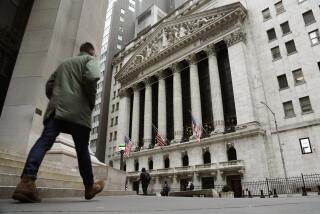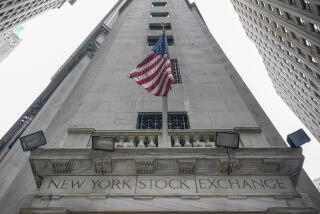U.S. to invest $250 billion in banks
- Share via
WASHINGTON — In a major strategic shift, the Bush administration has decided to pour at least $250 billion directly into major banks and expand federal insurance protection to encourage financial institutions to resume lending to one another.
Stocks soared on hopes that policymakers had finally hit on the right formula to thaw the frozen credit system and quell the financial calamity that has hammered giant banks and small investors alike. The Dow Jones industrial average rocketed more than 900 points, its biggest one-day point gain ever.
“The history of banking crises suggests very strongly that you need heavy government involvement. Half measures don’t work,” said Nariman Behravesh, chief economist at forecasting firm Global Insight. “This is a good thing. It’s about time.”
Scheduled to be rolled out early today by President Bush, the strategy closely resembles the path taken by Britain and the European Union, a route credited with reviving faltering stock markets there.
Under the new approach, which can be implemented under the $700-billion rescue plan approved by Congress this month, the federal government intends to pump capital into nine major banks and financial firms that agreed to participate during meetings with Treasury Secretary Henry M. Paulson on Monday.
In return, it’s expected the government would receive preferred nonvoting shares of their stock. Additional banks are expected to participate as the program moves forward, according to a person with knowledge of the plan who was not authorized to speak publicly.
In addition to helping recapitalize banks, the administration will also try to restart lending between banks by using the Federal Deposit Insurance Corp. to insure senior preferred bank debt, which commonly includes funds borrowed from other banks.
Many details are being worked out, but opening up the availability of credit is considered vital not only to the financial industry but also to the entire economy. Almost all businesses depend on credit for everything from meeting payrolls to making investments in new products and equipment.
Though the administration is moving ahead with plans to purchase hundreds of billions of dollars in toxic, mortgage-related securities -- the centerpiece of the original bailout scheme -- the new strategy is likely to move that into a secondary position.
For one thing, the asset-purchase program will take several more weeks if not months to get up and running. In the weeklong struggle to win congressional approval of the original bailout plan, Congress decided to grant the Treasury Department immediate access to only $250 billion. President Bush can authorize spending an additional $100 billion; anything beyond that can be blocked by Congress.
Assistant Treasury Secretary Neel Kashkari, in a speech on the overall rescue strategy, said the legislation approved by Congress at the beginning of the month gave the Treasury broad flexibility -- including the right to take equity positions in banks -- so it could adapt to changing conditions.
“The one constant throughout the credit crisis has been its unpredictability,” Kashkari said.
The administration, after some hesitation, has been moving toward the new approach for most of the last week, officials said, in part because direct government recapitalization became the favored approach of European banks, to which the U.S. financial system is tightly linked.
On Wednesday, Britain forced the issue by announcing it would spend $87 billion to take equity stakes in three of its banks. Over the weekend, countries that use the euro followed suit.
Government officials did not name the nine banks that would participate initially, but news reports late Monday included Citigroup Inc., Wells Fargo & Co., JPMorgan Chase & Co, Bank of America Corp., Goldman Sachs Group Inc. and Morgan Stanley.
If the new strategy brought cheers from some economists, at least some in the banking industry reacted with alarm as word of what was in the plan seeped out.
One industry insider, who spoke on condition of anonymity because he was not authorized to discuss the plan publicly, said he feared it would set off a firestorm of anger among the hundreds of banks not included in the initial phase of the program, as well as their customers.
“This worked in Sweden, where you have about 14 banks,” he said, referring to a successful Swedish intervention in a banking crisis several years ago. “Here we have thousands of banks. The guys at Treasury are thinking as Wall Street people. But they are about to bump into something called democracy. They are going to hear from 5,000 banks, 3,000 credit unions saying, ‘You are picking winners and losers.’ ”
Predicting that Paulson and his aides, many of whom are veterans of the big New York financial institutions, will focus on pumping up the Wall Street giants, he said, “It’s like picking your kids.”
Though stepped-up government intervention was well received in Europe, it may not fly as well in the U.S., said Edwin Truman, a senior fellow at the Peterson Institute for International Economics.
“We have a sharper distinction between the private sector and the public sector,” Truman said. “It’s a higher hurdle to jump in this country.”
Certainly direct federal purchase of bank stock -- a form of partial nationalization of the banking system -- requires an enormous compromise for an administration deeply committed to free-market economics and opposed to government meddling.
But Truman said that whatever the political reluctance, it was the right move economically.
“These kinds of crises are not unique to the United States,” Truman said. “There are a limited number of tools or techniques you can use, and that was one of them.”
Government officials were expected to provide details of the stock-purchase program and the new FDIC insurance program today. Both programs were designed to curb the cost to taxpayers over time. If the stock value of the financial institutions rises, the shares could be sold at a profit. The FDIC insurance program would be paid for with premiums from the banks.
Another reason for the shift in strategy was the ongoing volatility of stock markets around the world, which officials feared would make the economic downturn far worse. As markets reported loss after loss last week, economists grew increasingly pessimistic about the global economy.
Behravesh of Global Insight said that the best-case scenario he now saw was that unemployment would rise to 7% from its current 6.1%. The worst-case scenario would be 8% or 9%.
As a result, he said, the government had to act fast and act large. The weekend moves in Europe and the anticipated stock-purchase plan in the U.S. finally seemed to be enough to calm the markets, at least temporarily.
“Finally, there was concerted action and big action,” Behravesh said. “It was coordinated and it was big, and that’s why it worked.”
--
Times staff writers Nicole Gaouette and Tom Hamburger in Washington and Walter Hamilton in New York contributed to this report.
More to Read
Inside the business of entertainment
The Wide Shot brings you news, analysis and insights on everything from streaming wars to production — and what it all means for the future.
You may occasionally receive promotional content from the Los Angeles Times.










